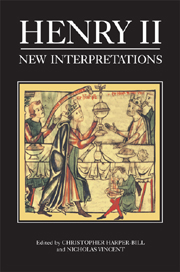Book contents
- Frontmatter
- Contents
- List of Illustrations
- Editor's Preface
- List of Abbreviations
- Introduction: Henry II and the Historians
- The Accession of Henry II
- Henry II and Louis VII
- Doing Homage to the King of France
- Henry, Duke of the Normans (1149/50–1189)
- Henry II and England's Insular Neighbours
- Henry II, the English Church and the Papacy, 1154–76
- On the Instruction of a Prince: The Upbringing of Henry, the Young King
- Henry II and the Creation of the English Common Law
- Finance and the Economy in the Reign of Henry II
- Henry II and the English Coinage
- The Court of Henry II
- Literary Culture at the Court of Henry II
- Henry II and Arthurian Legend
- Index
The Court of Henry II
Published online by Cambridge University Press: 12 September 2012
- Frontmatter
- Contents
- List of Illustrations
- Editor's Preface
- List of Abbreviations
- Introduction: Henry II and the Historians
- The Accession of Henry II
- Henry II and Louis VII
- Doing Homage to the King of France
- Henry, Duke of the Normans (1149/50–1189)
- Henry II and England's Insular Neighbours
- Henry II, the English Church and the Papacy, 1154–76
- On the Instruction of a Prince: The Upbringing of Henry, the Young King
- Henry II and the Creation of the English Common Law
- Finance and the Economy in the Reign of Henry II
- Henry II and the English Coinage
- The Court of Henry II
- Literary Culture at the Court of Henry II
- Henry II and Arthurian Legend
- Index
Summary
The court of King Henry II must rank as one of the least neglected institutions in history, viewed since the time of Walter Map as the very archetype of what a medieval princely court both should and should not be. Scholarly interest here merely reflects twelfth-century perceptions, since Henry's court is unique not only for the attention that it has attracted from nineteenth- and twentieth-century historians but for the breadth and richness of the contemporary reports it inspired from Walter Map, Gerald of Wales, John of Salisbury, Richard fitz Nigel, Roger of Howden, Peter of Blois and Stephen de Fougères, to name only the better known among a whole host of eye-witnesses. Moreover, nowhere else in twelfth-century europe can the testimony of chroniclers and courtiers be matched to so rich a surviving corpus of charters, Exchequer accounts and administrative records. Vastly more evidence survives of Henry's courtiers than from that other supposed paragon of twelfth-century courtliness, Capetian France. Our knowledge of the personal and prosopographical detail of Henry's court has been much enhanced by recent research, as has our understanding of its material culture, both in terms of building, and, thanks to Sybille Schröder, of such courtly commodities as venison, wine and cloth. Our insight into the general ethos and modus vivendi of princely courts has likewise been transformed. Taking their lead from early-modernists themselves trawling in the wake both of Lewis Namier and of the social anthropologists, students of Plantagenet history have embarked upon those turbulent waters where the shallower, stamp-collecting impulses of our discipline merge with the most unfathomable depths of theory.
- Type
- Chapter
- Information
- Henry IINew Interpretations, pp. 278 - 334Publisher: Boydell & BrewerPrint publication year: 2007



